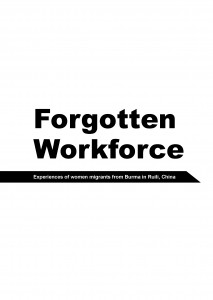Forgotten Workforce
By Burmese Women's Union • February 23, 2012 Burma’s continuing political repression and economic deterioration, coupled with China’s rapid growth, have caused a new phenomenon over the past few years: large-scale northward migration from Burma to China.
Burma’s continuing political repression and economic deterioration, coupled with China’s rapid growth, have caused a new phenomenon over the past few years: large-scale northward migration from Burma to China.
The Yunnanese border town of Ruili (called Shweli in Burmese) has seen an estimated tenfold increase in the number of migrants from Burma since 2006, with numbers now exceeding 100,000. Formerly mainly employed in the jade, transport and sex industries, migrants are now working in a range of sectors, including domestic work, restaurants and hotels, sales, construction and manufacturing industries.
Migrants are arriving from all parts of central and eastern Burma, particularly from the central dry zone, where continuing drought has deprived farmers of their traditional livelihoods. In Sagaing and Magwe, whole villages are draining of young people coming to find work in China.
A large proportion of the migrants are women. During 2010 the Burmese Women’s Union (BWU) conducted in-depth interviews with 32 of these women from various work sectors. Most were from Burma’s central divisions. About half were high school graduates, and some had even graduated from university, but none had been able to find jobs inside Burma.
Tags: Burmese Women's Union, China, Migrant Workers, WomenThis post is in: Spotlight, Women
Related Postsသတၱမအၾကိမ္ညီလာခံသက္တမ္း ပထမအၾကိမ္ ႏွစ္ပတ္လည္စုံအစည္းအေ၀း တႏိုင္ငံလုံးအပစ္အခတ္ရပ္စဲေရးႏွင့္ ႏိုင္ငံေရးေဆြးေႏြးပဲြမ်ားျဖစ္ေပၚလာေရးအပၚ သေဘာထားထုတ္ျပန္ေၾကညာခ်က္
ႏိုင္ငံတကာျငိမ္းခ်မ္းေရးေန႔ ထုတ္ျပန္ေၾကညာခ်က္
BWU’s New Report “Forgotten Workforce” Exposes Hardship of Burmese Migrant Women in China’s Border Boom Town
Statement on the 4th Anniversary of the Saffron Revolution
We Want Real Change in Burma, Not Public Relations Games









 All posts
All posts